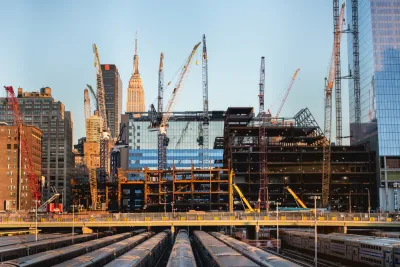Some state constitutions provide that citizens have the right to a healthy environment. But these seemingly innocuous provisions may lead to counterproductive results.

Numerous state constitutions include “environmental rights amendments” (ERAs) creating a public right to a clean environment. For example, New York’s amendment, enacted in 2021, provides that “[e]ach person shall have the right to clean air and water, and a healthful environment.”
At first glance, these provisions seem quite innocuous. Who could be against a “healthful environment?” However, the vagueness of this provision gives judges virtually unlimited powers of interpretation, and litigants virtually unlimited power to attack projects with lawsuits. As a result, ERAs can easily be manipulated to support some not-very-healthful results.
For example, suppose a city rezones to allow more housing in job centers served by excellent public transit. Obviously, this is an environmentally friendly policy; residents of transit-filled job centers such as New York City’s financial district are far more likely to use public transit or walk to work than residents of car-dependent suburbs.
Yet anti-development activists are already using the ERA as a tool to keep housing out of walkable areas. In response to a proposal to build new housing in New York’s Lower East Side (a neighborhood with a Walkscore of 96, less than two miles from the city’s Financial District) a group of project opponents have announced plans to file a lawsuit under New York’s ERA. The litigants claim that construction of new housing “exacerbates respiratory, cardiovascular, and mental health issues” in their community.
At first glance, this lawsuit seems implausible. Even if construction of housing in the Lower East Side would create noise or pollution, the same is true of construction anywhere in a city, or even in an inner-ring suburb next to existing housing or offices or stores. So if courts outlawed construction near existing development, development could only occur in the most remote, car-dependent suburbs, rather than in places near existing housing or jobs. So if the Lower East Side ERA suit succeeded, courts would essentially be mandating car-dependent suburban sprawl and forbidding all other construction- hardly a pro-environmental result.
One might argue that because this lawsuit is unlikely to succeed, the ERA is harmless. But even unsuccessful lawsuits (or the threat of one) can delay development. The experience of state environmental review statutes is relevant. Many states (such as New York) have laws requiring environmental impact statements for any activity that requires a government permit (such as a rezoning or a bike lane) that creates a significant environmental impact. These laws, unlike the ERA, do not directly prohibit controversial activity. Nevertheless, they are similar to an ERA in that they require courts to opine on what activities create environmental impacts. Opponents of buildings can use these laws to delay projects in a variety of ways—first by trying to stop a project until an environmental impact statement is filed, and then by challenging the statement as inadequate once it has been filed. If environmental review statutes can be misused to support sprawl and fight infill, so can ERAs.

Analysis: Cybertruck Fatality Rate Far Exceeds That of Ford Pinto
The Tesla Cybertruck was recalled seven times last year.

National Parks Layoffs Will Cause Communities to Lose Billions
Thousands of essential park workers were laid off this week, just before the busy spring break season.

Retro-silient?: America’s First “Eco-burb,” The Woodlands Turns 50
A master-planned community north of Houston offers lessons on green infrastructure and resilient design, but falls short of its founder’s lofty affordability and walkability goals.

Test News Post 1
This is a summary

Analysis: Cybertruck Fatality Rate Far Exceeds That of Ford Pinto
The Tesla Cybertruck was recalled seven times last year.

Test News Headline 46
Test for the image on the front page.
Urban Design for Planners 1: Software Tools
This six-course series explores essential urban design concepts using open source software and equips planners with the tools they need to participate fully in the urban design process.
Planning for Universal Design
Learn the tools for implementing Universal Design in planning regulations.
EMC Planning Group, Inc.
Planetizen
Planetizen
Mpact (formerly Rail~Volution)
Great Falls Development Authority, Inc.
HUDs Office of Policy Development and Research
NYU Wagner Graduate School of Public Service


























